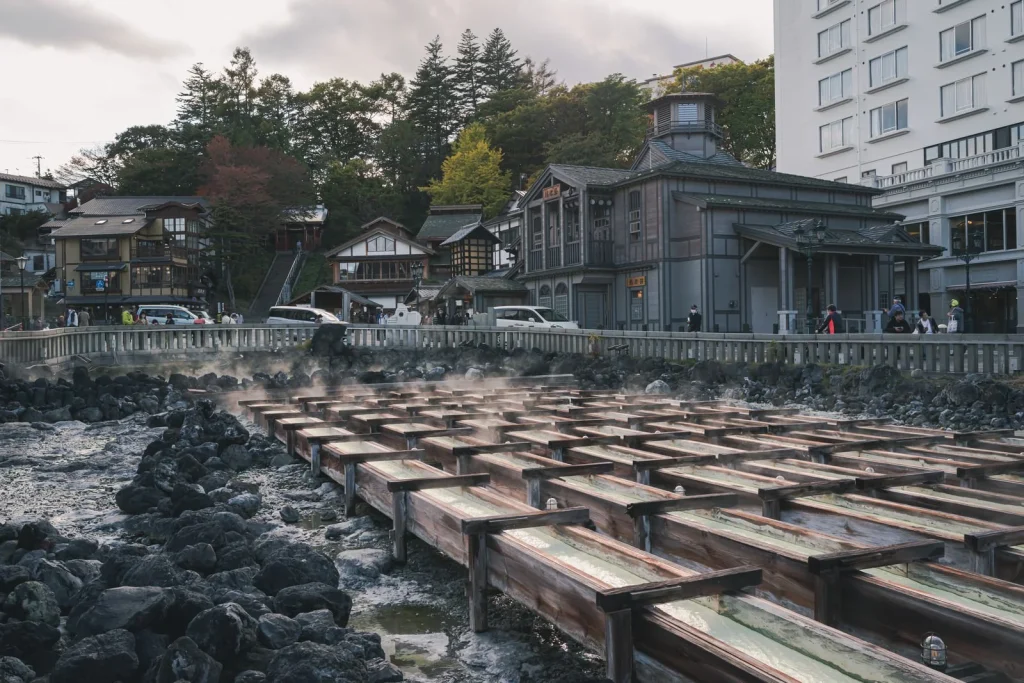Nestled in the heart of Japan, Gunma Prefecture unfolds as a hidden gem, offering a harmonious blend of natural wonders, cultural treasures, and delectable cuisine.
From the iconic hot springs of Kusatsu to the historical charm of Takasaki’s temples, Gunma beckons travelers with a diverse array of experiences.
In this comprehensive guide, we will embark on a detailed exploration of Gunma, unveiling specific attractions, savoring local delicacies, and uncovering the unique charm that defines this enchanting region.
Allure of Gunma

- Kusatsu Onsen: The Healing Waters of Yubatake: Kusatsu Onsen, renowned for its therapeutic hot springs, stands as one of Japan’s most celebrated onsen destinations. The iconic Yubatake, or hot water field, is a symbol of Kusatsu, where steaming waters cascade down wooden channels. Visitors can relax in the various public baths and ryokans while indulging in the rejuvenating benefits of the mineral-rich waters.
- Ikaho Stone Steps: Stairway to Scenic Serenity: Ikaho Onsen, known for its historic stone steps, offers a charming blend of hot springs and picturesque landscapes. The stone steps lead to the Ikaho Shrine and provide panoramic views of the surrounding mountains. The quaint shopping street, lined with traditional ryokans and shops, invites visitors to explore the local crafts and culinary delights.
- Takasaki Kannon Statue: A Symbol of Serenity: The Takasaki Kannon Statue, standing at 41 meters tall, is one of Japan’s tallest statues of Kannon, the Buddhist goddess of mercy. The statue is located in the Shōrin-ji Temple, providing a serene atmosphere for contemplation and reflection. The annual Shōrin-ji Temple Fire Festival, held in March, adds a vibrant touch to the cultural experience.
- Tomioka Silk Mill: Heritage of Industrial Innovation: The Tomioka Silk Mill, recognized as a UNESCO World Heritage Site, reflects Gunma’s rich history of industrial innovation. Built in the late 19th century, the mill played a crucial role in Japan’s silk industry. Guided tours of the mill showcase the historic machinery, worker dormitories, and the serene landscape surrounding the site.
- Shimonita: Indigo Dyeing Tradition: Shimonita, known for its indigo dyeing tradition, invites visitors to explore the world of Japanese craftsmanship. The Shimonita Konnyaku Museum showcases the production of konnyaku, a traditional Japanese jelly, and the indigo dyeing process. The town’s indigo-dyed products, including textiles and clothing, are unique souvenirs that highlight the region’s cultural heritage.
- Oze National Park: Alpine Meadows and Pristine Nature: Oze National Park, spanning Gunma, Fukushima, Niigata, and Tochigi Prefectures, is a pristine wilderness featuring alpine meadows, marshlands, and crystal-clear lakes. The Oze Hosoo Trail takes hikers through breathtaking landscapes, offering a chance to witness seasonal flora, including vibrant wildflowers in spring and golden marsh grasses in autumn.
- Shima Onsen: Tranquil Retreat Amidst Nature: Shima Onsen, nestled in the mountains, is a serene hot spring town with a rich history dating back over a thousand years. The picturesque Sessho-seki, or Killing Stone, adds a mystical touch to the landscape. Visitors can unwind in the town’s various ryokans, each with its unique charm, and explore the surrounding natural beauty.
- Mount Haruna: Volcanic Majesty and Scenic Drives: Mount Haruna, an active volcano, offers a majestic backdrop to the scenic drives around Lake Haruna. The Haruna Shrine, perched on the mountainside, provides panoramic views of the surrounding area. The annual Haruna Lake Ice Festival, held in winter, transforms the region into a wonderland of ice sculptures and festivities.
- Kanna-machi: The Town of Wind and Watermills: Kanna-machi, known as the “Town of Wind,” boasts traditional Japanese watermills that harness the power of the wind. The Kanna Thatched Roof Village showcases well-preserved thatched-roof houses, providing a glimpse into rural life in Japan. The Kanna-machi Wind and Watermill Festival, held in autumn, celebrates the town’s cultural heritage.
- Gunma’s Local Delicacies: Culinary Adventures Await: Gunma’s culinary scene is a celebration of local ingredients and traditional flavors. The region is renowned for its Joshu wagyu beef, characterized by its marbling and tenderness. Karinto Manju, a sweet confection featuring deep-fried dough filled with sweet red bean paste, is a popular local treat.Additionally, Gunma’s signature dish, Mizusawa udon, is a type of thick wheat noodle served in a savory soy-based broth. The town of Mizusawa is famous for its unique udon-making experience, allowing visitors to hand-make their own noodles and savor the authentic flavors of Gunma.
- Gunma Craft Beer: A Toast to Local Brews: Gunma has a burgeoning craft beer scene, with several breweries producing a variety of artisanal beers. The Gunma Craft Beer Festival, held annually, brings together local breweries and beer enthusiasts. Visitors can sample a diverse range of craft beers, each with its unique flavors, often inspired by the region’s natural ingredients.
- Kusatsu Traditional Performing Arts: Cultural Extravaganza: Kusatsu, in addition to its renowned onsen, hosts traditional performing arts events throughout the year. The Kusatsu Nohgaku Festival showcases Noh and Kyogen performances, providing a cultural immersion into Japan’s traditional theater arts. The festival’s vibrant costumes and theatrical presentations captivate audiences and add to the cultural richness of the region.
Conclusion:
Gunma Prefecture, with its diverse landscapes, cultural treasures, and delectable cuisine, stands as a destination that invites travelers to explore the essence of Japan. From the healing waters of Kusatsu Onsen to the historic Silk Mill of Tomioka, each destination within Gunma offers a unique and immersive experience. As you savor the flavors of Mizusawa udon and traverse the scenic drives around Mount Haruna, Gunma promises an unforgettable journey that celebrates the dynamic and welcoming nature of this captivating prefecture.



コメント